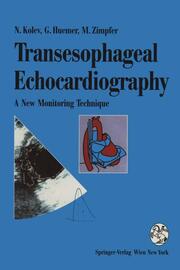Detailansicht
Transesophageal Echocardiography
A New Monitoring Technique
ISBN/EAN: 9783211826508
Umbreit-Nr.: 5539551
Sprache:
Englisch
Umfang: ix, 157 S.
Format in cm:
Einband:
kartoniertes Buch
Erschienen am 13.04.1995
Auflage: 1/1995
- Zusatztext
- Das Buch richtet sich vor allem an junge Anästhesiologen und Assistenzärzte auf Intensivstationen, die die Technik der transösophageale Echokardiographie erlernen möchten, aber ebenso an Kardiologen und Internisten, die Patienten kardiologisch betreuen.
- Autorenportrait
- Inhaltsangabe1 Introduction.- References.- 2 General theory, history and development.- Principles of two-dimensional echocardiography.- Principles of Dopper echocardiography.- Digital cine loop technology.- History and development of transesophageal echocardiography.- Characteristics of transesophageal systems.- References.- 3 Standard transesophageal imaging and planes.- General considerations.- Cardiac examination.- Transgastric views.- Midesophageal views.- Basal esophageal views.- References.- 4 On-line and off-line determinations of ventricular preloads and volumes.- Preload - clinical relevance.- Off-line echocardiography estimations of preload.- Prolate ellipse method, area-length approach.- Simpson's rule method.- On-line assessment of preload: acoustic quantification technique.- References.- 5 Assessment of afterload.- Clinical relevance.- Echocardiographic estimation of afterload.- References.- 6 Contractility.- Contractility indices revisited.- Cardiac output.- Two-dimensional method.- Doppler echocardiography method.- Theory.- Cardiac output by sampling the aortic valve.- Cardiac output by sampling the pulmonic valve.- Fundamental sources of error.- Comparison with other methods of cardiac measurement.- Uses of Doppler cardiac output in anesthesiology.- Ejection fraction.- Mean velocity of circumferential fiber shortening (Vcf).- Two-dimensional Doppler echocardiographic estimation of isovolumic phase indexes.- Peak rate of change of left ventricular pressure (dP/dt).- Isovolumic contraction time (IVCT).- Frank-Starling principle and end-systolic performance curves.- References.- 7 Perioperative myocardial ischemia.- Cardiac risk.- References.- Myocardial ischemia: pathophysiology and effects of the inhalational anesthetics.- References.- Left ventricular segmental wall motion analysis.- Experimental and clinical studies.- Standard TEE monitoring position.- General considerations.- Reference systems.- Methods for calculating the central reference (centroid) for an individual frame.- Systolic wall thickening analysis.- Biplane and multiplane TEE imaging.- Cine loop and SWMA.- Methodological problems.- References.- Automated on-line wall motion analysis.- Principles of border identification.- Principles of the internal "centroid" reference systems.- Wall motion versus wall thickening.- Conclusion.- References.- Myocardial ischemia and Doppler transmural diastolic flow.- Recording techniques and parameters of Doppler transmitral inflow.- Practical remarks on measurement of Doppler transmitral parameters.- Relation between mitral flow characteristic and hemodynamics.- Doppler transmitral flow for intraoperative diagnosis of acute myocardial ischemia.- References.- Myocardial perfusion by contrast echocardiography: new trend in ischemia detection (scenario of the year 2000).- Principles of contrast echocardiography.- Quantitative analysis of myocardial contrast two-dimensional echocardiography.- a) Assessment of the perfusion territory of regional myocardial perfusion mapping.- b) Qualification of regional myocardial blood flow.- Conclusion.- References.
